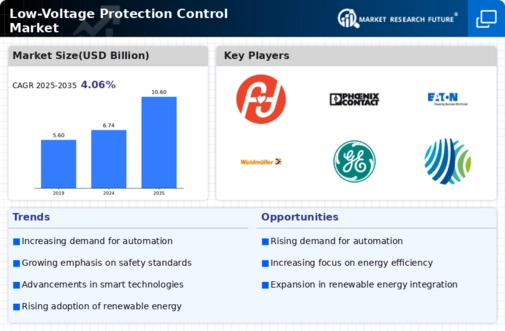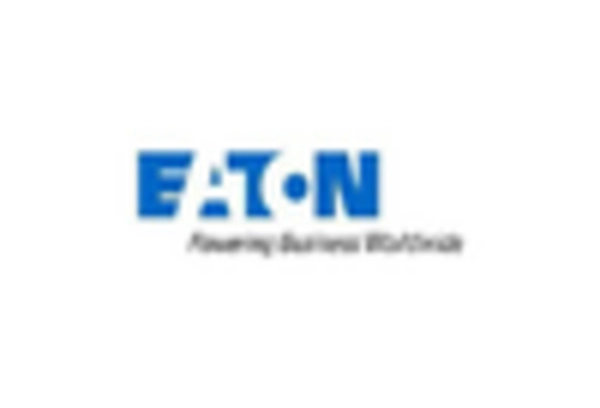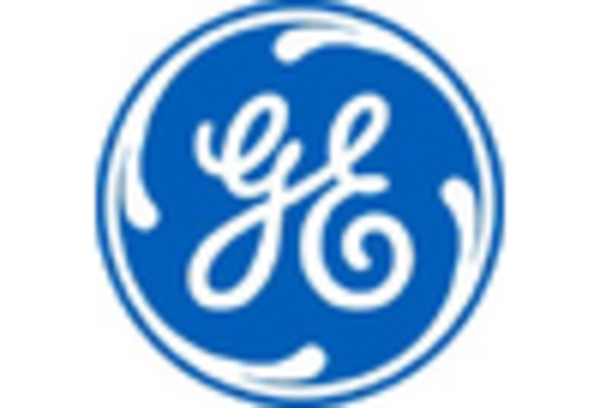Growing Industrial Automation
The trend towards industrial automation is significantly influencing the Low-Voltage Protection Control Market. As industries increasingly adopt automated processes, the need for reliable low-voltage protection systems becomes paramount. Automation not only enhances operational efficiency but also necessitates robust protection against electrical faults. Data suggests that the industrial automation market is projected to reach a valuation of over 300 billion dollars by 2026, which will likely drive demand for low-voltage protection solutions. These systems are essential for safeguarding automated machinery and ensuring uninterrupted operations. Consequently, the Low-Voltage Protection Control Market is positioned to benefit from this surge in automation, as manufacturers seek to integrate advanced protection technologies into their automated systems.
Rising Demand for Energy Efficiency
The increasing emphasis on energy efficiency is a pivotal driver for the Low-Voltage Protection Control Market. As industries and consumers alike seek to reduce energy consumption, the demand for low-voltage protection solutions that enhance efficiency is likely to rise. According to recent data, energy-efficient technologies can reduce energy use by up to 30 percent in certain applications. This trend is further fueled by government incentives and initiatives aimed at promoting sustainable practices. Consequently, manufacturers are compelled to innovate and develop advanced low-voltage protection systems that not only safeguard electrical equipment but also contribute to overall energy savings. This dual focus on protection and efficiency positions the Low-Voltage Protection Control Market favorably for growth in the coming years.
Expansion of Renewable Energy Sources
The expansion of renewable energy sources is a key driver for the Low-Voltage Protection Control Market. As the world shifts towards sustainable energy solutions, the integration of renewable sources such as solar and wind power necessitates robust low-voltage protection systems. These systems are essential for managing the variability and unpredictability associated with renewable energy generation. Market analysis indicates that the renewable energy sector is expected to grow at a compound annual growth rate of approximately 8 percent over the next decade. This growth will likely increase the demand for low-voltage protection solutions that can effectively handle the unique challenges posed by renewable energy integration. Consequently, the Low-Voltage Protection Control Market stands to benefit from this transition towards cleaner energy sources.
Increased Focus on Safety and Compliance
Safety and compliance regulations are becoming increasingly stringent, thereby driving the Low-Voltage Protection Control Market. Organizations are mandated to adhere to safety standards that protect both personnel and equipment from electrical hazards. This regulatory landscape compels companies to invest in low-voltage protection solutions that meet or exceed these requirements. Recent statistics indicate that non-compliance can result in significant financial penalties and operational disruptions. As a result, businesses are prioritizing the implementation of reliable protection systems to mitigate risks. The Low-Voltage Protection Control Market is likely to see a surge in demand as companies strive to comply with evolving safety regulations and protect their assets.
Technological Advancements in Protection Systems
Technological advancements play a crucial role in shaping the Low-Voltage Protection Control Market. Innovations such as smart circuit breakers, advanced relays, and integrated monitoring systems are transforming traditional protection mechanisms. These technologies enhance the reliability and responsiveness of low-voltage systems, thereby reducing the risk of electrical failures. Market data indicates that the adoption of smart technologies in protection systems is expected to grow at a compound annual growth rate of over 10 percent in the next five years. This growth is driven by the need for real-time monitoring and control, which allows for proactive maintenance and minimizes downtime. As a result, the Low-Voltage Protection Control Market is likely to witness increased investment in research and development to further advance these technologies.

















Leave a Comment